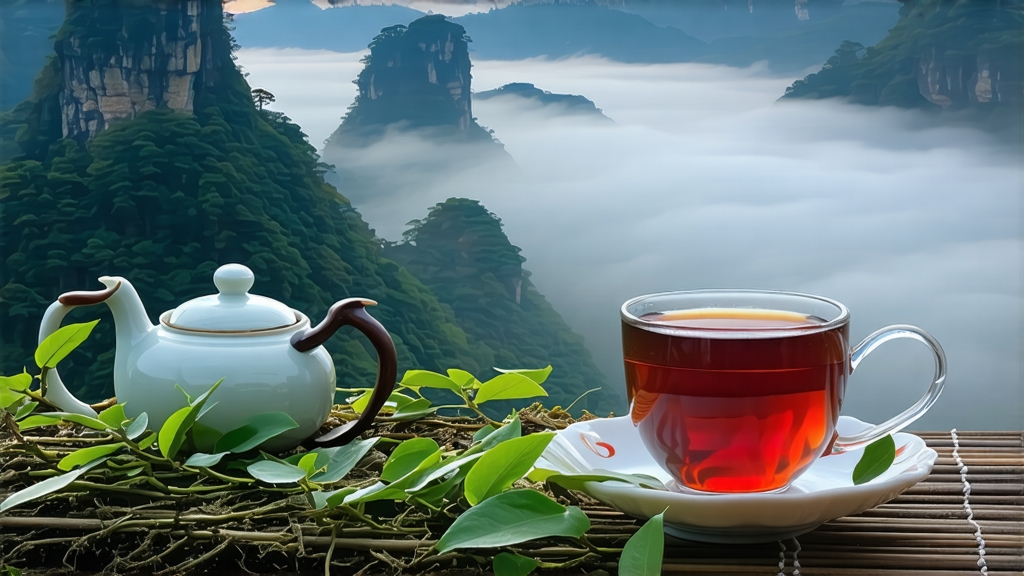
Long before Assam, Ceylon or Earl Grey existed, the first fully oxidised leaf ever purposefully created was born in the rugged Wuyi Mountains of northern Fujian. Locals call it Zheng Shan Xiao Zhong—“Small Leaf from the Original Mountain”—but the trading houses of old Canton anglicised it into the musical name we know today: Lapsang Souchong. To international drinkers the tea is famous for its campfire aroma; to Chinese connoisseurs it is the patriarch of all hong cha, the red teas the West labelled “black”. Understanding Lapsang Souchong is therefore the shortest route to understanding how China invented black tea, and how a single valley’s pine-scented smoke drifted across oceans to shape morning rituals from London to Lahore.
History: from Ming soldiers to Queen Victoria
Legend fixes the birth year at 1646, when Qing troops quartered in the Wuyi village of Tongmu demanded that tea farmers speed up drying to free the warehouses for army use. In desperation the villagers spread fresh leaves over pine fires; the resulting whisky-coloured liquor, far from spoiling, revealed a mellow sweetness framed by resinous smoke. Dutch and Portuguese merchants carried the novel tea to Europe where it fetched higher prices than green teas precisely because it survived the long sea voyage without losing flavour. By the 1660s the British East India Company was listing “Bohea Souchong” among its most valuable cargoes; a century later Queen Victoria’s court was diluting it with bergamot oil to create what became Earl Grey. Thus the same leaves that warmed Ming guerrillas ended up defining English teatime.
Terroir: why only Tongmu can claim the name
Authentic Zheng Shan Xiao Zhong is protected by China’s National Origin Mark. Geographically it must be grown within the 600–1 200 m elevation band of Tongmu Guan, a narrow gorge where the Wuyi massif funnels humid subtropical air into cool night mists. The soil is a stony, mineral-rich laterite derived from weathered tuff and granite; drainage is so rapid that roots plunge deep for water, concentrating amino acids. Around the tea gardens grow masson pines, Chinese firs and camphor trees whose fallen needles provide the smoking fuel later in the process. Attempts to replicate the tea in nearby counties—or in India, Kenya, even Fujian’s own lowlands—yield a coarser smoke or a flat, flaccid cup, proving that terroir is as decisive here as in Burgundy wine.
Cultivars: three bushes, three stories
Although foreigners speak of “Lapsang” as a monolith, Tongmu farmers distinguish at least three heirloom cultivars, each harvested in micro-lots:
- Cai Cha (“Vegetable Tea”) – the original seed-grown population bushes, small-leafed and slow to bud, producing a light, fruity liquor with the gentlest smoke.
- Xiao Ye Zhong (“Small Leaf Clone”) – a 1950s selection that gives a brighter red cup and a note of longan fruit; today it accounts for 70 % of export grade.
- Ye Shan Cha (“Wild Mountain Tea”) – scattered wild trees over 80 years old, hand-climbed to pick; their leaves are thicker, yielding a creamy texture and a cooling menthol finish that lingers for minutes.
Each cultivar is processed separately so that the final auction lots carry the bush identity on the bamboo packaging, a level of transparency still rare in the black-tea world.
Craft: turning green into smoke-kissed red
Plucking follows the Chinese solar calendar: the first flush begins when local peaches bloom, usually between Qingming and Guyu (early to mid-April). Only the standard “two leaves and a bud” is taken, yet the leaf must be mature enough to show a faint oil sheen—an indicator of high catechins that will oxidise into aromatic theaflavins.
Withering is done in the second storey of the wooden tea house, a loft whose slatted floor allows pine smoke to rise from the ground-hearth below. Fresh trays of leaves lose 60 % of their moisture in four hours, absorbing resinous volatiles such as alpha-pinene and bornyl acetate that later bond with leaf polyphenols, creating the tea’s signature pine-and-fruit bouquet.
Rolling is still performed by foot—literally.